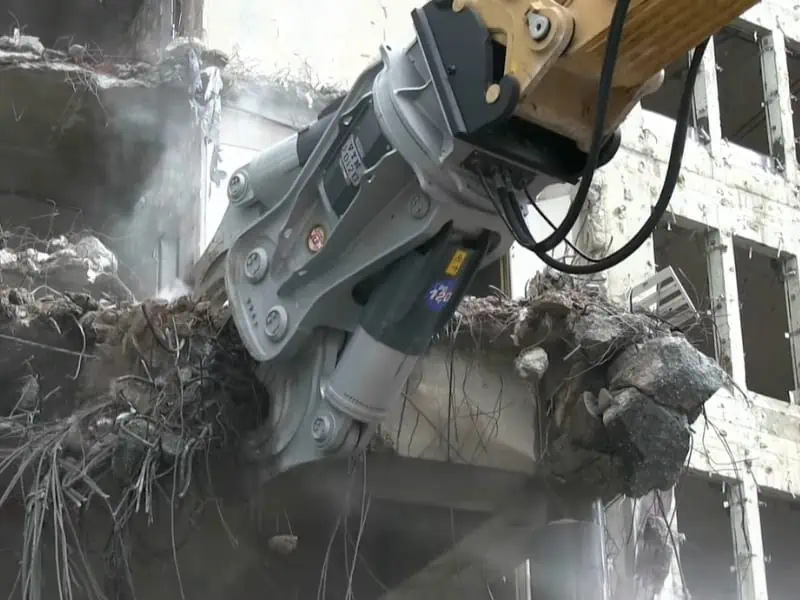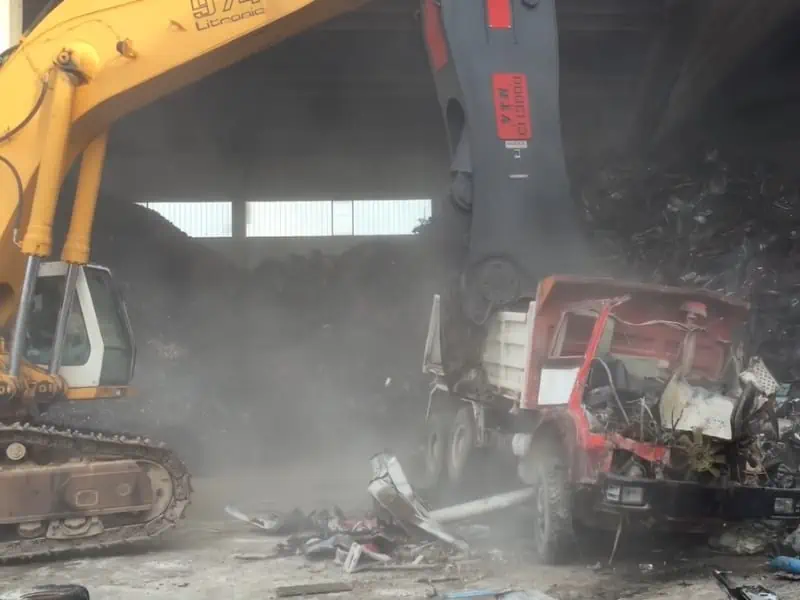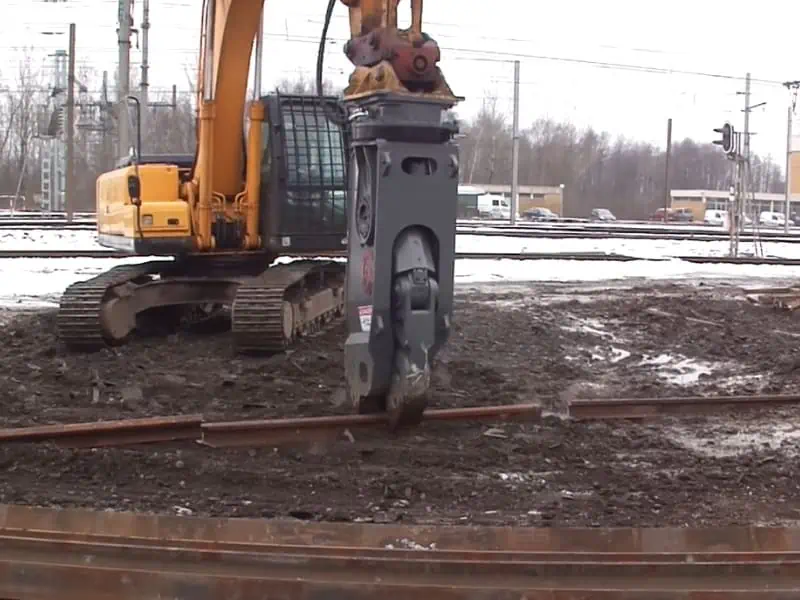A hydraulic Mini Excavator shear is a tool designed to cut through tough materials using hydraulic power. Specifically, a mini excavator hydraulic shear is a smaller version of this tool designed to be used with a mini excavator.
The hydraulic shear works by using hydraulic pressure to force two blades together, creating a cutting force that can slice through materials like steel or concrete. It is useful for construction or demolition projects where these materials must be cut or broken down. A steel shear is a specialized machine designed specifically for cutting through steel. It is a powerful and efficient tool used in demolition projects where large steel plates or girders must be cut.
The steel shear is particularly useful in applications where it is important to avoid generating sparks or flames, such as when cutting through steel structures in ships or airplanes. It is because sparks and flames can pose a fire hazard or cause damage to sensitive equipment nearby.
In addition to ship and airplane demolition, steel shears are used in scrapyards to break down large metal objects into smaller pieces for recycling. It helps reduce waste and conserve natural resources. The mini excavator shear has specialized grapples that can easily cut and lift heavy materials such as wire, rebar, pipe, strapping, I-beams, and concrete. This versatile tool boasts an improved weight-to-cutting ratio, providing greater efficiency and cost savings than other cutting methods.
The mini excavator shear is made from durable tool steel and features reversible cutting blades with multiple edges, which can be easily shimmed, re-sharpened, and replaced. It enhances the longevity of the cutting blades and reduces maintenance costs.
А mini excavator shear is constructed from high-strength materials, ensuring improved durability and increased operating stability. It is also lightweight, making it suitable for use with micro-mini excavators.
The mini excavator shear is designed with a one-cylinder system that delivers a secure and powerful crushing force, efficiently cutting through a wide range of materials. The mini excavator shear is a reliable and cost-effective solution for cutting and lifting heavy materials on construction sites and other industrial applications.
Оглавление
ПереключатьDifferent types of mini excavator shear
Demolition Shears:
These are the most common type of mini excavator shear, designed for cutting through concrete, metal, and other materials. They are ideal for demolition, easily cutting through walls, pillars, and beams.

Metal Shears:
As the name suggests, metal shears are designed for cutting through metal materials, such as steel plates, girders, and pipes. They are commonly used in industrial applications where precision cutting is required.
Scrap Shears:
Scrap shears are specifically designed for use in scrap yards, where they are used to cut through metal scraps, such as cars, appliances, and machinery. They are designed to handle high-volume cutting and are often equipped with grapples for easier lifting and loading.

Hydraulic Rotating Shears:
These mini excavator shears are designed with a rotating head, allowing for greater flexibility in cutting angles and positions. They are commonly used in construction and demolition projects requiring a wide range of cutting angles.
Rail Shears:
Rail shears are designed for cutting through railroad tracks and other similar materials. They are ideal for railway maintenance and repair work.

Wood Shears:
Wood shears are designed for cutting through timber and other wooden materials. They are commonly used in forestry, landscaping, and construction applications.
How to use mini excavator shear
Prepare the site:Ensure the site is clear of any obstructions or hazards that could interfere with the operation of the shear. It includes checking for underground utilities and marking them if necessary.
Attach the mini excavator shear:Attach the mini excavator shear to the excavator’s hydraulic system using the appropriate coupling. Follow the manufacturer’s instructions for proper attachment.
Position the mini excavator:Position the mini excavator and shear in the appropriate location for cutting. Ensure the excavator is stable and level.
Select the appropriate cutting tool:Select the appropriate cutting tool based on the material to be cut. It needs changing the shear blades or adjusting the cutting pressure.
Start cutting:Activate the hydraulic system and cut through the material. Follow the manufacturer’s instructions for proper cutting technique, pressure, and speed.
Monitor the cutting process:Monitor the cutting process to ensure the shear functions properly, and the material is cut safely and efficiently.
Complete the cutting process:Once the material has been cut, lift and remove it from the site using the mini excavator’s grapple or other lifting device.
Shut down the hydraulic system:When the cutting process is complete, shut down the hydraulic system and remove the mini excavator shear from the excavator.
Uses of mini excavator shear
Demolition work:
Mini excavator shears are commonly used for demolition work, easily cutting through walls, pillars, and beams. They are ideal for demolishing concrete and metal structures.
Scrap yards:
Mini excavator shears are also used in scrap yards for cutting through metal scraps, such as cars, appliances, and machinery. They are designed to handle high-volume cutting and are often equipped with grapples for easier lifting and loading.
Construction:
Mini excavator shears are often used in construction projects for cutting through concrete, rebar, and other materials. They are ideal for cutting through reinforced concrete and other tough materials.
Railway maintenance:
Mini excavator shears are also used for railway maintenance and repair, cutting through railroad tracks, and other similar materials. They can make quick work of cutting through steel and other metals.
Forestry and Landscaping:
Mini excavator shears can be used for forestry and landscaping work, cutting through trees, branches, and other wooden materials. They can quickly clear land and remove unwanted trees and brush.
Industrial applications:
Mini excavator shears are commonly used in industrial applications like metal fabrication and manufacturing. They are ideal for cutting through steel plates, girders, and pipes.
Specification table of different mini excavator shear
| Specification | Model 1 | Model 2 | Model 3 |
|---|---|---|---|
| Weight | 500 kg | 850 kg | 1200 kg |
| Excavator weight | 1-2 tons | 2-4 tons | 4-6 tons |
| Blade length | 360 mm | 450 mm | 550 mm |
| Cutting force | 27 tons | 45 tons | 65 tons |
| Max. jaw opening | 450 mm | 550 mm | 650 mm |
| Max. cutting capacity | 30 mm steel / 300 mm | 40 mm steel / 400 mm | 50 mm steel / 500 mm |
| concrete | concrete | concrete | |
| Oil flow | 20-40 L/min | 40-70 L/min | 70-100 L/min |
| Pressure | 160-200 bar | 200-250 bar | 250-300 bar |
| Excavator attachment | Pin-on or Quick coupler | Pin-on or Quick coupler | Pin-on or Quick coupler |
| Blade material | Hardox steel | Hardox steel | Hardox steel |
| Suitable for | Micro and mini excavators | Mini and midi excavators | Midi and larger excavators |
| up to 2 tons | up to 4 tons | up to 6 tons |
How to choose the mini excavator shear
Cutting capacity:
The cutting capacity of the shear is one of the most important factors to consider. The shear must be capable of cutting through the materials you will be working with, such as concrete, steel, or wood. Check the shear’s specifications to ensure it has the cutting capacity you need.
Excavator compatibility:
The mini excavator shear must be compatible with your excavator. Check the shear’s specifications to ensure it can be attached to your excavator’s hydraulic system and that the weight and size of the shear are suitable for your excavator.
Cutting force:
The cutting force of the shear is another important factor to consider. The shear must be powerful enough to cut through tough materials but not so powerful that it damages the excavator or the cut material. Check the shear’s specifications to ensure it has the appropriate cutting force for your needs.
Blade durability:
The durability of the shear blades is also important. Look for shear with blades made from high-quality materials that can withstand repeated use without damage or wear out. Blades that are reversible and have multiple cutting edges can also be a good option, as they can be sharpened and reused multiple times.
Safety features:
The shear should have safety features that protect the operator and the excavator. Look for features such as blade guards, locking mechanisms, and emergency stop buttons.
Brand reputation:
Finally, consider the reputation of the brand and manufacturer. Look for a manufacturer with a good reputation for producing high-quality, reliable products, and check for reviews and feedback from other customers to ensure you are getting a product that meets your needs.
Заключение
The mini excavator shears are versatile and powerful attachments that can be used for various demolition and recycling applications. Users can achieve increased efficiency, safety, and cost savings in their demolition and recycling operations by selecting the appropriate mini excavator shear. For further information, you can contact us.
